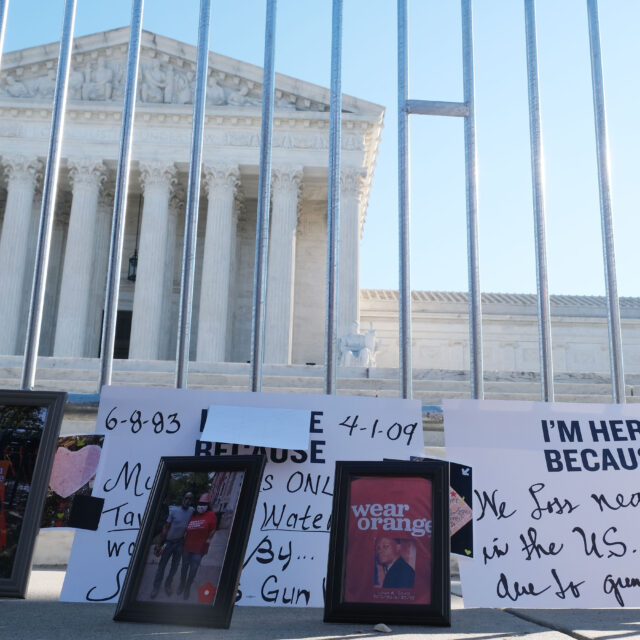“Dangerous People Shouldn’t Have Guns”: Disarming Domestic Abusers Under Justice Barrett’s Originalism

11.3.2023
“History is consistent with common sense: it demonstrates that legislatures have the power to prohibit dangerous people from possessing guns.” Those were the words written in 2019 by then-Judge Amy Coney Barrett, in a dissenting opinion she wrote in a case called Kanter v. Barr. In that case, Barrett was arguing that the Second Amendment did not allow the disarming of a non-violent (and in her view non-dangerous) felon—a dubious proposition that continues to divide courts around the country. But on November 7, the broader question she addressed—whether the government can prohibit from possessing guns people who present a danger to public safety—will take center stage when the Supreme Court hears oral argument in United States v. Rahimi.
The Rahimi case raises the specific question of whether disarming domestic abusers subject to domestic violence restraining orders (DVROs) violates the Second Amendment. In late 2019, Zackey Rahimi dragged his girlfriend across a parking lot, shoved her in a car causing her head to collide with the dashboard, shot his gun toward a bystander, and later threatened to shoot his girlfriend. When she took him to court and obtained a DVRO, Rahimi was specifically warned that it would be a crime for him to have a gun while the order was in effect. When he subsequently violated the order in multiple ways and was found in possession of a pistol and a rifle, he was prosecuted and sentenced to prison under the federal law that makes it a crime to possess a firearm while subject to a DVRO.
But then there was an earthquake in Second Amendment law: in June 2022, the Supreme Court decided a case called NYSRPA v. Bruen. At its narrowest, the Bruen decision struck down a 100-year old New York law limiting who could carry a concealed firearm in public. More sweepingly, the six-Justice conservative majority announced that Second Amendment challenges would now be assessed by an originalist test focused on text and history and turning largely on whether today’s modern gun laws are consistent with “our Nation’s historical tradition of firearm regulation.”
Purporting to apply this history-focused test, earlier this year three judges of the Fifth Circuit concluded that Zackey Rahimi’s conviction must be overturned because, in their view, the federal law disarming domestic abusers subject to DVROs violates the Second Amendment.
Which brings us back to then-Judge Barrett’s dissent in Kanter v. Barr. Regardless of what one thinks of the Supreme Court’s history-focused approach to constitutional decision-making in the Second Amendment context, the Barrett dissent makes clear that even under an originalist test, and whatever the outer bounds of legislatures’ power to restrict who can have firearms, at a minimum “dangerous people” can be disarmed.
In her opinion, Justice Barrett reviewed writings of members of the founding generation at the time of the adoption of the Bill of Rights, pre-founding English laws, and early enactments by “founding-era legislatures [that] categorically disarmed groups whom they judged to be a threat to the public safety.” Her conclusion as to what history showed: “the legislature may disarm those who have demonstrated a proclivity for violence or whose possession of guns would otherwise threaten the public safety,” including “dangerous people who have not been convicted of felonies.” Zackey Rahimi plainly fits into this category.
And yet, the Fifth Circuit didn’t think so. The three-judge panel focused instead on the fact that, in 1791, there were no laws disarming domestic abusers subject to civil protective orders (which is not surprising given that, back then, domestic homicide using firearms was rare and women’s legal status much less equal). In effect, the Fifth Circuit did what even the conservative Bruen majority said lower courts should not do: require a “historical twin” in order to uphold a modern-day gun regulation.
That some of the most conservative, self-avowed originalists on the federal bench can’t even agree amongst themselves whether history supports categorical disarmament of people with dangerous histories speaks to the subjectivity and manipulability of the originalist test set out by Justice Thomas in Bruen. But the bottom line is that, even within Bruen’s flawed framework, Justice Barrett will be hard-pressed to walk away from her conclusion in Kanter that laws focused on taking guns away from those who “threaten the public safety” are supported by history.
Simply put, as Justice Barrett later said in a speech, “[d]angerous people shouldn’t have guns.” Even Larry Keane, an attorney, head of the gun industry’s main lobbying group, and self-proclaimed originalist, recently conceded that he believes “SCOTUS will reverse [the Rahimi decision] bc [of] history/tradition of keeping guns from dangerous people,” citing the Barrett dissent in Kanter. The NRA too was forced to acknowledge in its Rahimi amicus brief to the Supreme Court “the undeniable principle that violent and dangerous individuals can be deprived of their Second Amendment rights”—but argued, contrary to then-Judge Barrett’s Kanter dissent, that a criminal conviction is required before this can happen.
Putting history aside, Justice Barrett was also correct to observe that “common sense” supports disarming dangerous people—and domestic abusers are an especially dangerous group. On average, 70 women are shot and killed in acts of domestic violence each month. The presence of a gun in a home with a domestic abuser increases the risk a woman will be killed by five times. All of this is why 48 states and territories have laws that, like the federal law, require or allow the disarmament of domestic abusers in order to save lives. And numerous studies show that these laws are effective in reducing intimate partner homicides.
So let’s be clear: whether one thinks originalism is a good or a bad approach to constitutional decisionmaking, anything but a reversal in Rahimi will mean more women, children, families, law enforcement officers, and other people all across this country will die at the hands of armed domestic abusers. Let us hope that common sense prevails, Justice Barrett sticks to her guns, and the Supreme Court confirms that domestic abusers can (and must) be disarmed.





